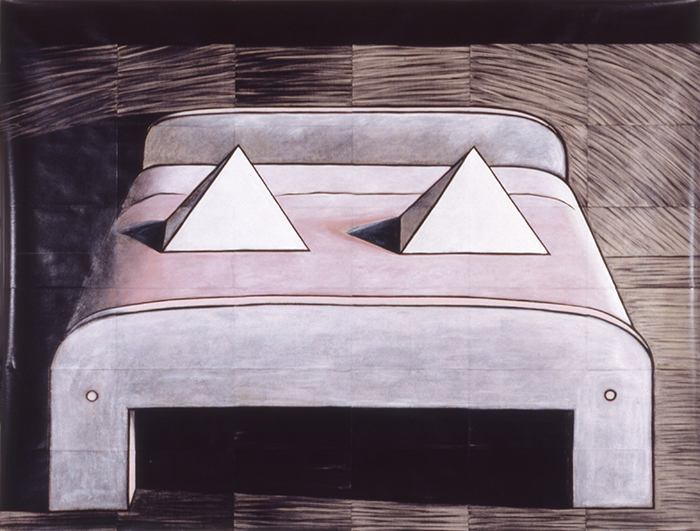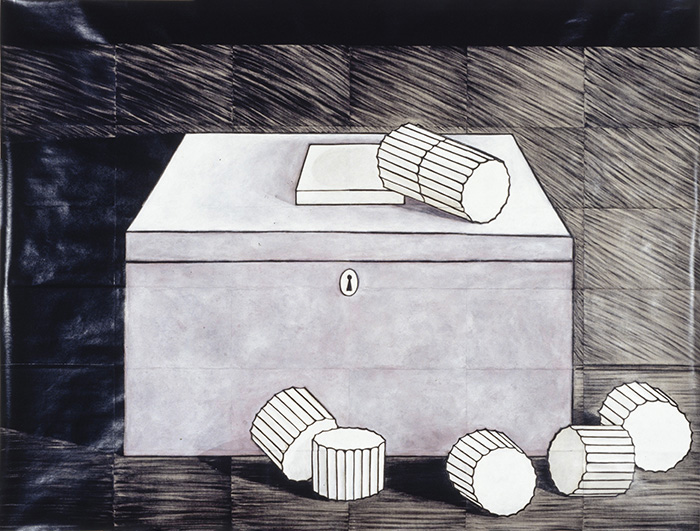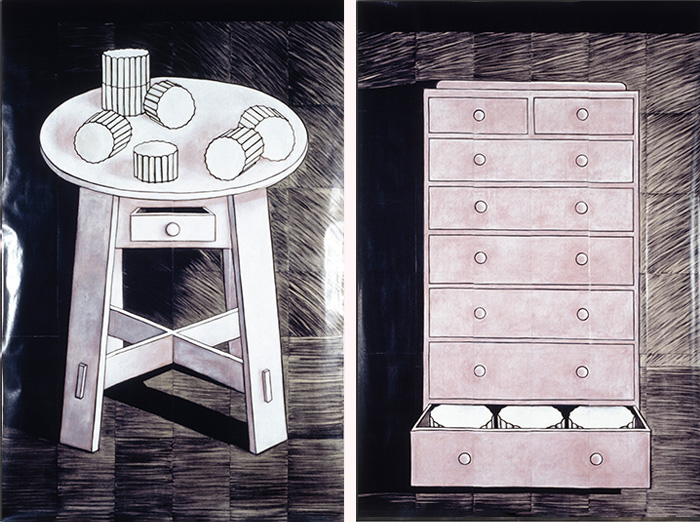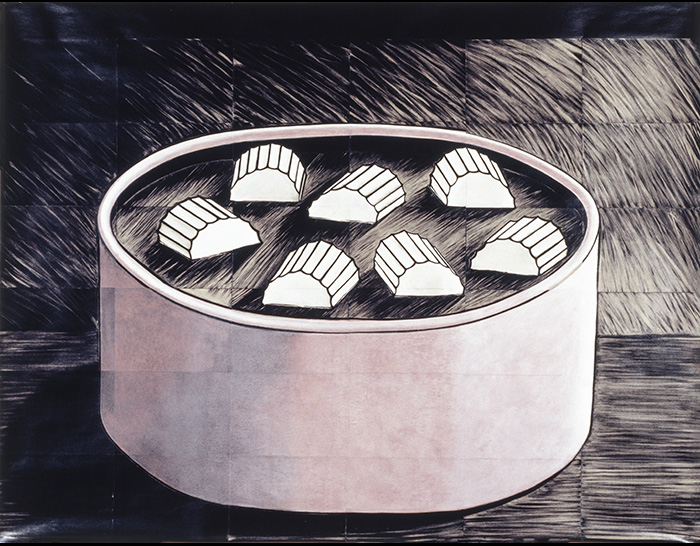FAMILIAR MONUMENTS
mixed media - 1994:96
 FM-chair
FM-chair  FM-cupboard
FM-cupboard  FM-bed
FM-bed  FM-box
FM-box FM-table & drawers
FM-table & drawers  FM-bath
FM-bath Photo credit: Bryan James, GBAG
Familiar monuments
chair, bed, cupboard, box, bath (mixed media 1800mmx1360mm), table and drawers (mixed media 1360mmx1800mm)
Door, window, world: Maree Horner, J.C. Sturm
Artspace Aotearoa,Tāmaki Makaurau-Auckland
11th February-6th April 2023
Selected works from the Familiar monuments series; cupboard, chair, bed, bath, drawers
![]()
Artspace Aotearoa ︎
Victoria Wynne-Jones - Art Now ︎
Familiar monuments
Govett Brewster Art Gallery, Ngāmotu-New Plymouth
21st September-3rd November 1996.
This series of seven works by Maree Horner could be seen to pose a question that is basic to our being. That question could be framed as: How to represent in an artwork the relationship between the male and the female, between the masculine and the feminine, in an incisive and telling way.
To that end, it can be noted, that each work presented here contextualises a cultural or artistic element, the Greek fluted column or the shape of the Egyptian pyramid, within the matrix of a familiar or domestic piece of furniture. What at a glance might seem incongruous, such as a pyramid on a chair, or two pyramids on a bed, seems also, somehow, sardonically correct. These works suggest that the domestic item is in some way the centre within which the meaning of the columns and pyramids may come to rest. Better still that they attain their true and full meaning when determined in that way. The whole weight of culture might, in the end, find its denouement in relation to a piece of furniture.
To understand this seeming paradox, to throw some light on the intent of these works, it might be instructive to consider the Greek Temple or the Egyptian Pyramid, in relation to its native landscape. The Greek Temple is usually set in a symbolic relationship to the valleys and clefts, the mountains and peaks nearby, whilst the Egyptian Pyramids stand in their permanence against the ubiquitous shifting sands of the desert. Valiant as they might be in their defiance of the surroundings, in their pseudo sylvan whiteness or monumental scale relative to man, they are still dwarfed by their settings, by the undeniability of Nature and the inevitability of the Earth.
In general the contrast here is between Mother Nature and the assertions of a masculine paradigm. The columns of the Temple capped by the pediment and the outer form of the Pyramid thrusting to the sky assert their masculinity over the feminine reading of the same shapes as containers with their usually discreet entrances and germaine insides. As if to emphasise the masculine dimension of the cultural element these works use the phallocentricity of the single column, or the closed tetrahedron of the pyramid. We are left in no doubt as to their sexual symbolism and so in no doubt as to the gender of the contextualising shapes. The keyhole of the BOX, the open drawer in the TABLE, the CUPBOARD ajar, the soft enclosing forms of the CHAIR, and the landscape of the BED, suggest or even better insist, that the relation in each work is between the female and the male.
If the Temple in the landscape or the Pyramid in the desert is indeed a male element conceptualized by Mother Earth then what we have to come to understand is why in these works items of furniture take that role instead and do so with an effect that renders the whole equation perhaps more precisely than a painting of the original in its setting would do. If, this time, the nature of the interior of the Temple or the Pyramid is taken into account rather than its relationship to its surroundings we are minded that within the original Temples and Pyramids furniture abounded either to serve the needs of worship or the needs of the dead. From the Egyptian pyramids particularly extant items of furniture have a reality and a presence at least as palpable as, if not more than, the remnants of the dead.
What we have to face in these works is the fact that in a sense the original has been turned inside out in relation to itself. How more ironical, to convey the sense of context than to employ the domestic contrivances that epitomise the femme, at least as convention would have it.
... continue reading essay ︎
chair, bed, cupboard, box, bath (mixed media 1800mmx1360mm), table and drawers (mixed media 1360mmx1800mm)
Door, window, world: Maree Horner, J.C. Sturm
Artspace Aotearoa,Tāmaki Makaurau-Auckland
11th February-6th April 2023
Selected works from the Familiar monuments series; cupboard, chair, bed, bath, drawers

Artspace Aotearoa ︎
Victoria Wynne-Jones - Art Now ︎
Familiar monuments
Govett Brewster Art Gallery, Ngāmotu-New Plymouth
21st September-3rd November 1996.
This series of seven works by Maree Horner could be seen to pose a question that is basic to our being. That question could be framed as: How to represent in an artwork the relationship between the male and the female, between the masculine and the feminine, in an incisive and telling way.
To that end, it can be noted, that each work presented here contextualises a cultural or artistic element, the Greek fluted column or the shape of the Egyptian pyramid, within the matrix of a familiar or domestic piece of furniture. What at a glance might seem incongruous, such as a pyramid on a chair, or two pyramids on a bed, seems also, somehow, sardonically correct. These works suggest that the domestic item is in some way the centre within which the meaning of the columns and pyramids may come to rest. Better still that they attain their true and full meaning when determined in that way. The whole weight of culture might, in the end, find its denouement in relation to a piece of furniture.
To understand this seeming paradox, to throw some light on the intent of these works, it might be instructive to consider the Greek Temple or the Egyptian Pyramid, in relation to its native landscape. The Greek Temple is usually set in a symbolic relationship to the valleys and clefts, the mountains and peaks nearby, whilst the Egyptian Pyramids stand in their permanence against the ubiquitous shifting sands of the desert. Valiant as they might be in their defiance of the surroundings, in their pseudo sylvan whiteness or monumental scale relative to man, they are still dwarfed by their settings, by the undeniability of Nature and the inevitability of the Earth.
In general the contrast here is between Mother Nature and the assertions of a masculine paradigm. The columns of the Temple capped by the pediment and the outer form of the Pyramid thrusting to the sky assert their masculinity over the feminine reading of the same shapes as containers with their usually discreet entrances and germaine insides. As if to emphasise the masculine dimension of the cultural element these works use the phallocentricity of the single column, or the closed tetrahedron of the pyramid. We are left in no doubt as to their sexual symbolism and so in no doubt as to the gender of the contextualising shapes. The keyhole of the BOX, the open drawer in the TABLE, the CUPBOARD ajar, the soft enclosing forms of the CHAIR, and the landscape of the BED, suggest or even better insist, that the relation in each work is between the female and the male.
If the Temple in the landscape or the Pyramid in the desert is indeed a male element conceptualized by Mother Earth then what we have to come to understand is why in these works items of furniture take that role instead and do so with an effect that renders the whole equation perhaps more precisely than a painting of the original in its setting would do. If, this time, the nature of the interior of the Temple or the Pyramid is taken into account rather than its relationship to its surroundings we are minded that within the original Temples and Pyramids furniture abounded either to serve the needs of worship or the needs of the dead. From the Egyptian pyramids particularly extant items of furniture have a reality and a presence at least as palpable as, if not more than, the remnants of the dead.
What we have to face in these works is the fact that in a sense the original has been turned inside out in relation to itself. How more ironical, to convey the sense of context than to employ the domestic contrivances that epitomise the femme, at least as convention would have it.
... continue reading essay ︎